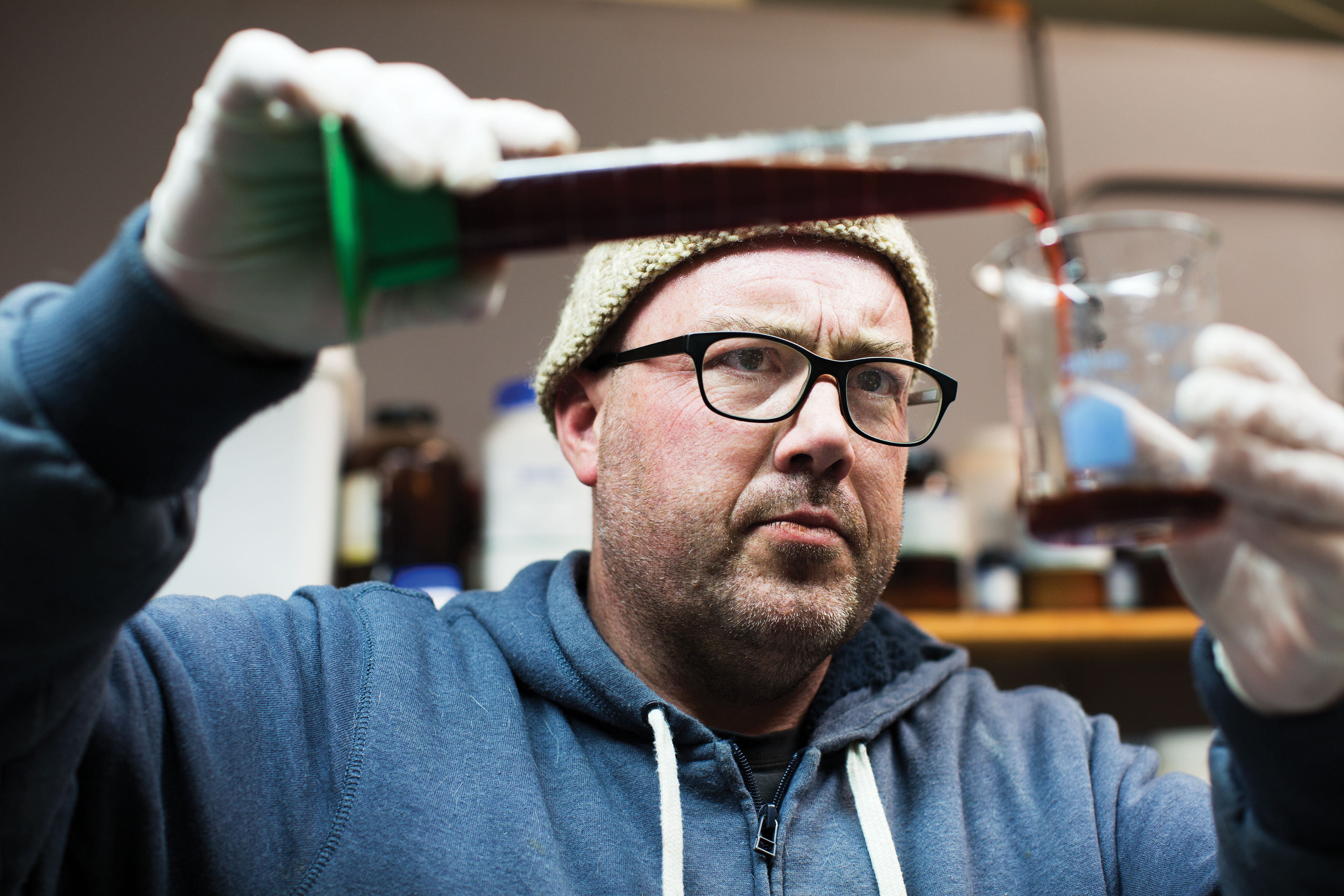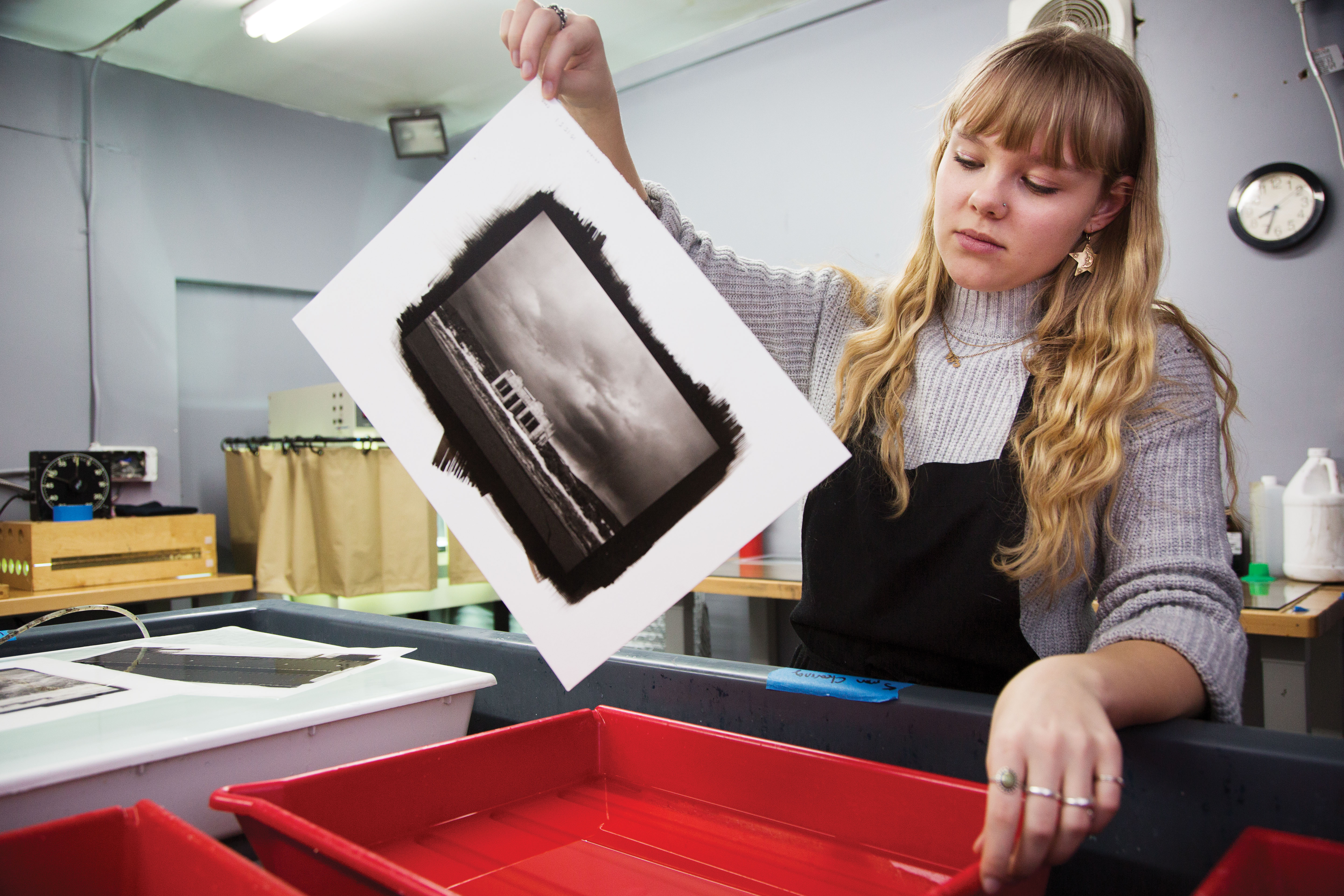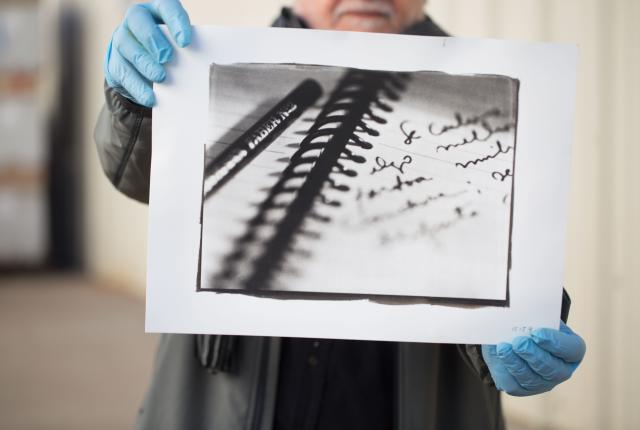Above: A Platinum-Palladium print from a Bostick & Sullivan printing workshop. Photograph by Inga Hendrickson.
Chiara Brandi carries the piece of paper flat, barely clasping its hand-torn edges, as if it were something hot or terribly fragile. She slides it carefully into a red plastic tray, then lifts the tray with her left hand and rocks it, sending waves of fluid over the paper. Almost instantly it begins to change. First, a wide, brown border reveals where she used a soft brush to paint a rectangle of a platinum-based emulsion, crafted with a precise formula. To make it, she measured 16 drops of palladium #3 in a little cup, then added 15 drops of ferric oxalate, five drops of sodium platinum, and one drop of Tween 20, a type of detergent that helps emulsify the other drops. Now she must work quickly and fight the thick watercolor paper’s desire to drink up the amber liquid—it had taken a lot of brushing to get the emulsion just right. Inside the dark border, something pale and curved takes shape.
At Bennington College, in Vermont, Brandi works mostly in color photography and collage, but she needed a semester of internship credit. By happy coincidence, Bostick & Sullivan, one of the biggest, best, fully stocked photo supply companies in the nation, is located in Santa Fe, which happens to be in her hometown, and it needed an intern.
We call it “alternative” now, but the exceptionally rich range of tones produced by platinum and palladium printing has made it a favorite of art photographers and amateur ethnographers for more than 100 years. Edward S. Curtis, Imogen Cunningham, Paul Strand, Edward Steichen, Alfred Stieglitz, Edward Weston, Laura Gilpin, Robert Mapplethorpe, and Sebastião Salgado all made pictures this way. The method faded as the silver gelatin process became the standard for black-and-white photography. Then color pushed that out of the picture. These days, everyone has access to photographic devices, taking pictures with cameras and phones but rarely creating prints of those images. As those digital images multiply on the cloud, platinum printing is nonetheless coming back into vogue, at least in some specialized circles. No darkroom is needed, the images can be exposed with sunlight, and the thick paper prints are a gloriously tactile antidote to our increasingly tech-dominated lives. Where iPhone pics and Snapchats are ephemeral, the platinum process produces the most durable prints you can make.
Our mostly middle-aged group of shutterbugs have various reasons for converging like pilgrims at one of Bostick & Sullivan’s multi-day workshops. I count three serious amateur photographers. The first is a retired Dallas lawyer and part-time Santa Fean whose parents were professional photographers; he worked with them as a teenager, shooting weddings, funerals, baby pictures—anything folks in Greenville, Texas, needed. The second is a cinematographer from Los Angeles who makes his living shooting TV shows but has begun to exhibit his still photography. The third is a student from Brazil who has self-published a volume of his graphic street photography. Then there’s me, a writer/wannabe photographer who brought her iPhone snaps.
 Above: Platinum-Palladium prints develop during a Bostick & Sullivan printing workshop.
Above: Platinum-Palladium prints develop during a Bostick & Sullivan printing workshop.
“The digital negative has made it easier for a wider number of people to do this kind of printing,” Melody Bostick says in the short hallway that serves as her office. “You can be in the 21st century making your negative, then go to the 19th century and make your print.” And perhaps that’s really what we students have in common: the desire to time-travel through the history of photography, soaking up the best ideas of each century. We share a love of the process, a desire to get our hands dirty, to pour our creative energy into something labor-intensive, and to take home the enduring evidence of our work. Inside Bostick & Sullivan’s headquarters, in an industrial area of Santa Fe’s south side, the darkroom is mostly quiet as we work, all of us deep in concentration. A humidifier gurgles softly in a pointless battle against Santa Fe’s dry winter air. A small fan blows in front of the drying rack, fluttering the finished prints. We hover around the long darkroom sink, rocking our babies in their wet cradles. Our work is safe to do with the lights on, so we can see one another’s photographs clearly: In one tray, fat, wet snowflakes fall from heavy clouds to frost a hillside of piñon trees; in another, wisps of smoke snake up from censers on the elaborate altar of an empty shrine; and in my water tray, two tiny figures bask in bikinis while the crenellated walls of a medieval city dominate the port behind them.
 Above: Dana Sullivan of Bostick & Sullivan Photography Prints.
Above: Dana Sullivan of Bostick & Sullivan Photography Prints.
Bostick & Sullivan has been in Santa Fe for nearly a quarter century, but its customer base is worldwide. If you work in old-time photographic processes, you know Melody Bostick and Richard Sullivan, because they’ve been supplying the ingredients for it since 1980. They relocated here from Los Angeles for the combination of (what was) cheap industrial space and (what still is) a vibrant photographic community. It’s a family affair. Melody manages the business end, and Richard, her husband, constantly hones his chemistry. Their son Dana manages the lab and leads workshops, and Dana’s wife, Leigh, does the accounting. Their expertise is supplemented by successive crops of young artists who come to Santa Fe to intern, like Brandi, or work at the shop, like Christi Wiltenburg, whose name we repeat like a mantra. Hey, Christi! How many drops? Hey, Christi! How many minutes? Hey, Christi!
“There’s nobody else who does what we do,” Dana Sullivan says as he imports another of my iPhone pictures, opens it in Photoshop, and, with a few quick clicks, turns it into a digital negative and prints it on a sheet of clear plastic film. “In order to remain viable, we have to continually look at where we think the future of alternative photography might go and how we can build a hybrid connection between us and the digital world.” Recent developments have made it much easier to work in this hybrid world. To do this kind of work at home, all you’d really need is a mid-range Epson printer, Adobe Photoshop, watercolor paper, a handful of trays and brushes, a frame for printing, sunlight (or a UV lamp), and one of Bostick & Sullivan’s chemical kits.
Dana has noticed renewed interest in albumen printing, an old process that, yes, involves egg whites. This has prompted him to launch into research and development. “There may have been 10 or 20 different ways to do it in the 1880s, when it was in its heyday,” he says. “So I’m testing lots of different formulas to come up with the best-looking final image with the least amount of hassle for the customer. Then we’ll turn it into a prepackaged kit, so the customer can open the box and start working.”
 Above: Chiara Brandi moves a print from the cleaning tray to the water bath.
Above: Chiara Brandi moves a print from the cleaning tray to the water bath.
When I take my newly made negative back into the darkroom, I see that Brandi’s image has developed fully. It’s a self-portrait. The artist/model kneels on a white sheet on a bed, facing away from the camera toward a blank wall, her arms extended above her head and her torso bent slightly to the left. It’s a simple, quiet tableau, a classic idea, but there’s a twist. As she leans over the tray, Brandi’s face looks porcelain, perfect. But in the picture, dark marks splotch her back. Chicken pox, she says. She’d been stuck in the house, contagious and bored, so she turned the camera on herself.
“Like Imogen Cunningham,” says Paul Plunkett, the retired lawyer. Of course. Cunningham had learned platinum printing working with Edward Curtis on his series The North American Indian. Later, tethered to home by three small children, she turned her eye to the objects at hand—magnolia blossoms, calla lilies, and other flora—and transformed them into fine art. I have a book of her work at home. On the cover is a picture called The Unmade Bed, just a handful of hairpins sitting on a rumpled white sheet. More than 60 years separate their pictures—it could be 100—but how wonderful that a magical blend of new and old tech could make Chiara Brandi and Imogen Cunningham seem like contemporaries.

PHOTO HISTORICA 2019
See Bostick & Sullivan demonstrate platinum-palladium and wetplate tintype printing July 5–7 at this free three-day show and sale of handmade alternative-process prints at El Museo Cultural, in Santa Fe. With cyanotype-making for kids, speaker presentations, and a display of large-format cameras.
PLATINUM-PALLADIUM WORKSHOPS
Instructors help turn your digital images into full-size negatives for printing during these three-day classes taught by Dana Sullivan and Christi Wiltenburg. Other multiday classes focus on creating the digital negatives, making wet-plate tintypes, and exploring other alternative processes such as cyanotype, Van Dyke brown print, salted paper, and kallitypes. Check their website for a schedule.


